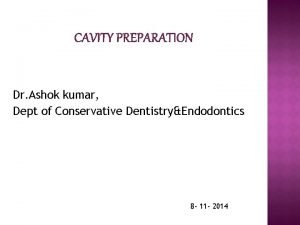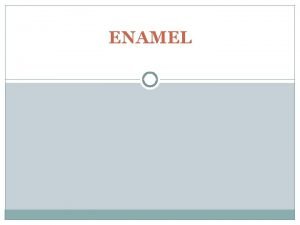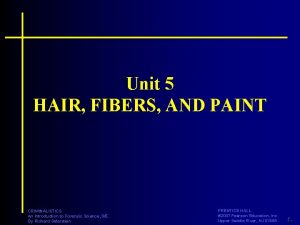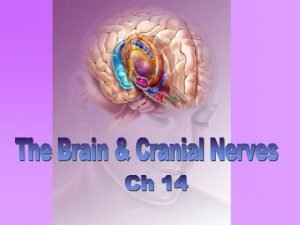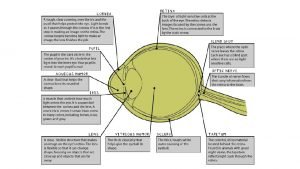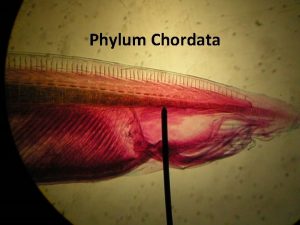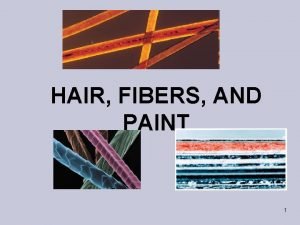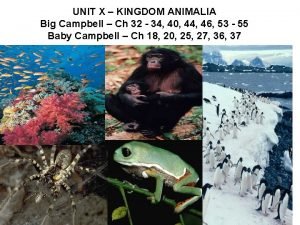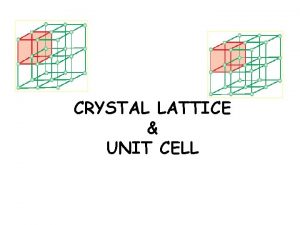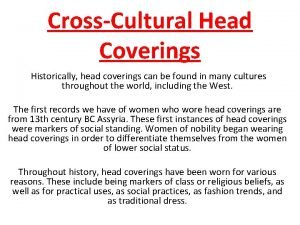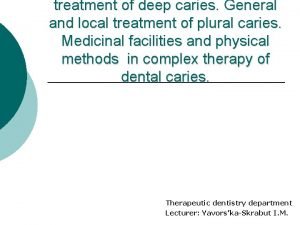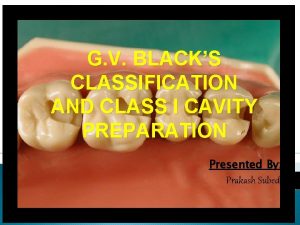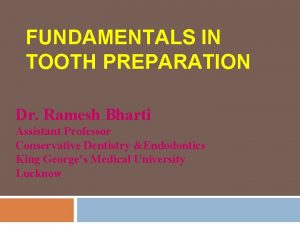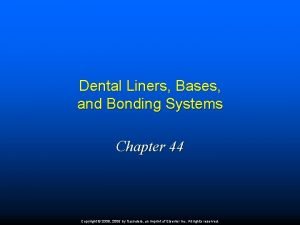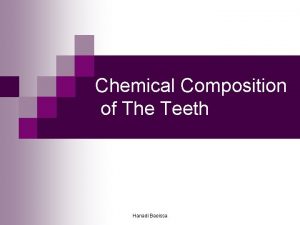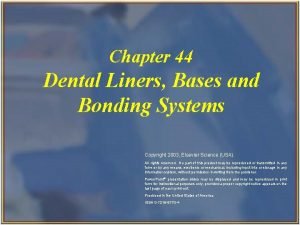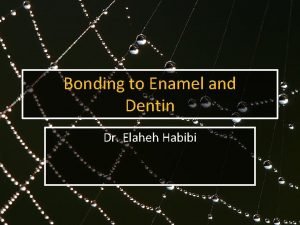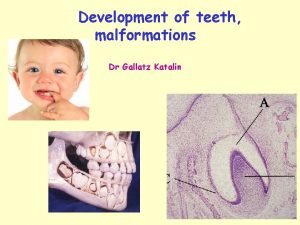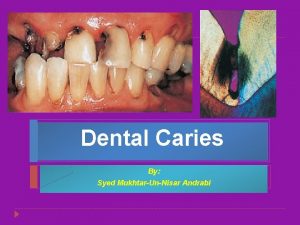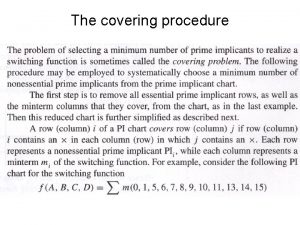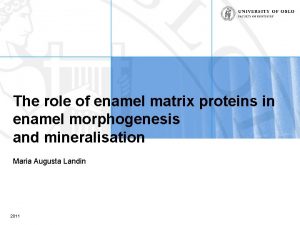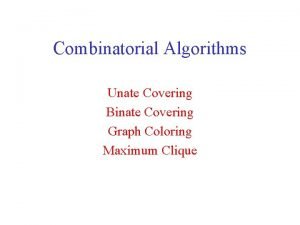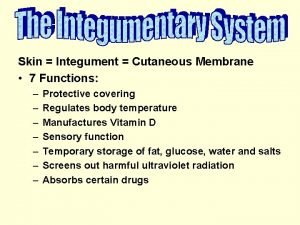ENAMEL Physical characteristics Enamel forms a protective covering






















































- Slides: 54

ENAMEL

Physical characteristics • Enamel forms a protective covering of variable thickness over the entire surface of the crown. • On the cusps of human molars and premolars the enamel attains a maximum thickness of about 2 to 2. 5 mm, thinning down to almost a knife edge at the neck of the tooth.

• The enamel was found to be thicker in the lingual surfaces of maxillary molars and in the buccal surfaces of mandibular molars. • As these are supporting cusps adaptation to functional demands.

• Because of its high content of mineral salts and their crystalline arrangement, enamel is the hardest calcified tissue in the human body. The function of the enamel is to form a resistant covering of the teeth, adaptation them suitable for mastication.

• The structure and hardness of the enamel makes it brittle, which is particularly obvious when the enamel loses its foundation of sound dentin. • At the surface the modulus of elasticity is higher and the hardness is more than on dentinoenamel junction.

• The density decreases from the surface to the deeper regions and from cuspal to incisal region. • Enamel has always been observed as a non electrical conductive material: it is in fact an insulator at room temperature. • Enamel is its permeable permitting complete or partial passage of certain molecules.

• The color of the enamel ranges from yellowish white to grayish white is determined by differences in the translucency of enamel, yellowish teeth having a thin, translucent enamel through which the yellow color of the dentin is visible and grayish teeth having a more opaque enamel. This due to variations in the degree of calcification and homogeneity of the enamel

• . Grayish teeth frequently show a slightly yellowish color at the cervical areas. • Incisal areas may have a bluish tinge where thin edge consists only of a double layer of enamel. Dehydration decreased the translucency but it was reversed on rehydration.

Chemical properties: • Inorganic material (96%) The inorganic material of the enamel is hydroxyapatite. Its chemical formula is Ca 10 (PO 4)6(OH 4)2. They are hexagonal in cross-section. The crystals are arranged to form enamel rods or enamel prisms.


• The hydroxyapatite crystal has a central core or C axis of hydroxyl ion around which calcium and phosphorus ions are arranged in the form of triangles. Carbonate rich crystals are preferentially attacked by acids in caries

• Organic substance and water (4%). Water is present as a part of the crystal (hydroxyapatite), between crystals and between rods and surrounding the rods. Pores are present between the crystals, especially at the boundaries of the rods and these are filled with water. • The organic material consists of some unique proteins Enamel proteins do not contribute to structuring of enamel. This is in contrast to collagen, which is the principal protein of dentin or bone, having a structuring function. •

The proteins found in the enamel are of two main groups: • Amelogenins, are a heterogenous group of low molecular weight proteins, accounting for about 90% of the enamel proteins. They are hydrophobic. Most of the secreted amelogenin is removed during maturation have a functional role in maintaining spaces between the crystals. In the fully formed enamelogenin remains in between the crystals and also surrounding them. .

• Amelogenins were also found in the acellular cementum. May be involved in the formation of acellular cementum and help in the regeneration of cementum in teeth affected by periodontal diseases

• Nonamelogenins constitute about 10% of enamel matrix proteins. • Enamelin, ameloblastin and tuftelin are the important proteins of this group. Nonamelogenins are high molecular weight proteins. • Ameloblastin and enamelin help in nucleation and growth of crystals.

• Tuftelin, on the hand, is localized to DEJ and is suggested to be involved in cell signaling. Amelotin, a new protein be secreted by maturative ameloblast. This protein is suggested to help in enamel formation.

Enamel microscopical Structure: • The enamel is composed of • 1 -Enamel rods or prisms: which are cylindrical, in longitudinal section, therefore the term rods. From the dentinoenamel junction the rods run twisting courses outward to the surface of the tooth. The length of most rods is greater than the thickness of the enamel because of the oblique direction and the wavy course of the rods.


• The rods located in the cusps, the thickest part of the enamel, are longer than those at the cervical areas of the teeth. The diameter of the rods averages 4 μm, but this measurement necessarily varies, since the outer surface of the enamel is greater than the dentinal surface where the rods originate. The diameter of the rods increases from the dentinoenamel junction toward the surface of the enamel at a ratio of about 1: 2.

• In cross-sections of human enamel, many rods resemble fish scales, keyhole- or paddle- shaped prism. When cut longitudinally sections pass through the “heads” or “bodies” of one row of rods and the “tails” of an adjacent row. The “bodies” of the rods are nearer occlusal and incisal surfaces, whereas the “tails” point cervically. At least two ameloblasts are involved in the synthesis of each enamel rod.


• One interpretation of the relationships between the key hole-shaped enamel rods and the roughly hexagonal ameloblasts is indicated. The bulk of the “head” of each rod is formed by one ameloblast, whereas three others contribute components to the “tail” of each rod. According to this interpretation, each rod is formed by four ameloblasts, and each ameloblast contributes to four different.


2 -rod sheaths. • 3 - cementing interprismatic substance

Direction of rods: • Generally the rods are oriented at right angles to the dentin surface. In the cervical and central parts of the crown of a deciduous tooth they are approximately horizontal. Near the Incisal edge or tip of the cusps they change gradually to an increasingly oblique direction until they are almost vertical in the region of the edge or tip of the cusps. •


Gnarled enamel: • Optical appearance of enamel presents at the tip of the cusps due to twisted enamel rods around each other in complex arrangement. They arranged in radial manner in horizontal plane.

Enamel Striations: • 1 -Cross striations : Each enamel rod is arranged of segments separated by dark lines that give it a striated appearance. • These cross striations demarcate rod segments and become more visible by the action of mild acids. • The rods are segmented because the enamel matrix is formed in a rhythmic manner.


2 -Hunter–Schreger bands: • The more or less regular change in the direction of rods may be regarded as a functional adaptation, minimizing the risk of cleavage in the axial direction under the influence of occlusal masticatory forces. The change in the direction of rods is responsible for the appearance of an optical phenomenon the Hunter–Schreger bands.


• These are alternating dark and light strips of varying widths that can best be seen in a longitudinal ground section under oblique reflected light. • They originate at the dentinoenamel border and pass outward, ending at some distance from the outer enamel surface.

3 -Incremental lines of Retzius • The incremental lines of Retzius appear as brownish bands in ground sections of the enamel. They explain the incremental pattern of the enamel, that is, the successive apposition of layers of enamel during formation of the crown. In longitudinal sections they surround the tip of the dentin.


• In the cervical parts of the crown they run obliquely. • In cross sections of a tooth the incremental lines of Retzius appear as concentric circles. • They may be compared to the growth rings in the cross-section of a tree. • The term “incremental lines” reflect variations in structure and mineralization, either hypomineralization or hypermineralization, that occur during growth of the enamel.

• The mean daily rate of enamel formation of about 3. 5 microns increases from inner to outer enamel and decreases from incisal/cuspal region to cervical enamel. The evenly spaced striae of Retzius was shown to represent a 6– 11 day rhythm in enamel formation while other Retzius lines are suggested to be due to stress.

4 -The neonatal line or neonatal ring: • The boundary between the two portions of enamel in the deciduous teeth is marked by an accentuated incremental line of Retzius. It appears to be the result of the abrupt change in the environment and nutrition of the newborn infant. The enamel of the deciduous teeth develops partly before and partly after birth. The prenatal enamel usually is better developed than the postnatal enamel.


Surface structures: • 1 - Prismless enamel: A relatively structureless layer of enamel, approximately has been described in 70% of permanent teeth and all deciduous teeth. It is found least often over the cusp tips and most commonly toward the cervical areas of the enamel surface.

2 -Perikymata • is transverse, wave-like grooves, believed to be the external manifestations of the striae of Retzius. They are continuous around a tooth and usually lie parallel to each other and to the cementoenamel junction. The enamel rod ends are concave and vary in depth and shape. They are shallowest in the cervical regions of surfaces and deepest near the incisal or occlusal edges


3 - Cracks : • the narrow, fissure-like structures that are seen on almost all surfaces they are actually the outer edges of lamellae. They extend for varying distances along the surface, at right angles to the dentinoenamel junction, from which they originate. Most of them are less than a millimeter in length, but some are longer, and a few reach the occlusal or incisal edge of a surface. They are fairly evenly spaced, but long lamellae appear thicker than short ones.

5 -Enamel cuticle: • A delicate membrane called Nasmyth’s membrane, after its first investigator, or the primary enamel cuticle covers the entire crown of the newly erupted tooth but is probably soon removed by mastication. Electron microscopic studies have indicated that this membrane is a


• atypical basal lamina found beneath most epithelia secreted by the ameloblasts when enamel formation is completed. The function of enamel cuticle is to protect the surface of enamel from the resorptive activity of the adjacent vascular tissue prior to the eruption of the teeth.

6 - Pellicle: • erupted enamel is normally covered by a precipitate of salivary proteins. This pellicle reforms within hours after an enamel surface is mechanically cleaned. Within a day or two after the pellicle has formed, it becomes colonized by microorganisms to form a bacterial plaque.

Dentinoenamel junction • The surface of the dentin at the dentinoenamel junctions is pitted. Into the shallow depressions of the dentin fit rounded projections of the enamel. This relation assures the firm hold of the enamel cap on the dentin therefore, the DEJ appears not as a straight but as a scalloped line. The DEJ, which is a series of ridges is more pronounced in the occlusal area, where masticatory stresses are greater.

Structured related to D. E. J: • 1 -Enamel lamellae: • Enamel lamellae are thin, leaf-like structures that extend from the enamel surface toward the DEJ. They may extend to, and sometimes penetrate into, the dentin. They consist of organic material, with but little mineral content makes possible the distinction between cracks and enamel lamellae.


Three types of lamellae can thus be differentiated: • 1 -Type A, lamellae composed of poorly calcified rod segments restricted to the enamel • 2 -Type B, lamellae consisting of degenerated cells; • 3 - Type C more common. • Types B and C may reach into the dentin. • Lamellae arising in erupted teeth where the cracks are filled with organic matter originating from saliva. • It has been suggested that enamel lamellae may be a site of weakness in a tooth and may form a road of entry for bacteria that initiate caries may act as pathways for caries producing bacteria.

2 -Enamel tufts • Enamel tufts arise at the DEJ and reach into the enamel to about one 13 -15 of its thickness. They resemble tufts of grass when viewed in ground sections. Tufts consist of hypocalcified enamel rods and interprismatic substance. Like the lamellae, they extend in the direction of the long axis of the crown. Therefore they are seen abundantly in horizontal section.


3 - Odontoblast processes and enamel spindles: • Occasionally odontoblast processes pass across the dentinoenamel junction into the enamel. Since many are thickened at their end they have been termed enamel spindles. They seem to originate from processes of odontoblasts that extended into the enamel epithelium before hard substances were formed at right angles to the surface of the dentin. The structure of the spindles were similar to enamel tufts and that both of them were hypomineralized or partially mineralized structures

 Undermined enamel vs unsupported enamel
Undermined enamel vs unsupported enamel Characteristics of enamel
Characteristics of enamel Cigna vitamin d policy
Cigna vitamin d policy Cigna not covering vitamin d testing
Cigna not covering vitamin d testing Hair under microscope
Hair under microscope What membrane covers the heart
What membrane covers the heart Sequential covering algorithm
Sequential covering algorithm Medulla hair
Medulla hair Formal letter for placing order
Formal letter for placing order Covering of brain
Covering of brain Thick tough white outer covering eyeball
Thick tough white outer covering eyeball Set covering machine
Set covering machine Signed statement for head covering
Signed statement for head covering Name two basic reasons for covering cargo on an open bed
Name two basic reasons for covering cargo on an open bed An animal that has a notochord
An animal that has a notochord Whats a covering letter
Whats a covering letter What does the medulla do in hair
What does the medulla do in hair Covering of spermatic cord
Covering of spermatic cord Covering tracks
Covering tracks Cotoderm
Cotoderm Two week notice letter example
Two week notice letter example Oolab orthotics
Oolab orthotics Onyxhophosis
Onyxhophosis Double layered membrane
Double layered membrane Locating tetrahedral and octahedral voids
Locating tetrahedral and octahedral voids Christian headcovering
Christian headcovering Body covering of animals
Body covering of animals Outer covering definition
Outer covering definition Find duck
Find duck Epididis
Epididis Rigid outer covering of plant cells
Rigid outer covering of plant cells Floor covering weekly top 50
Floor covering weekly top 50 Tough outer covering of bone
Tough outer covering of bone Why are related forms more agreeable than unrelated forms
Why are related forms more agreeable than unrelated forms Contracted form of shall not
Contracted form of shall not Why are related forms more agreeable than unrelated forms
Why are related forms more agreeable than unrelated forms Why are related forms more agreeable than unrelated forms?
Why are related forms more agreeable than unrelated forms? Strong and weak forms of auxiliary verbs
Strong and weak forms of auxiliary verbs Amalgam of the deep
Amalgam of the deep Cervical enamel projection
Cervical enamel projection Ankylosis cementum
Ankylosis cementum Cutting instrument formula
Cutting instrument formula Cavity preparation classification
Cavity preparation classification Primary resistance form
Primary resistance form Enamel niche
Enamel niche An example of enamel bonding is the placement of a:
An example of enamel bonding is the placement of a: Enamel composition
Enamel composition Dental liners bases and bonding systems
Dental liners bases and bonding systems Wet bonding vs dry bonding
Wet bonding vs dry bonding Enamel defect
Enamel defect Gallatz
Gallatz Zones of dentinal caries
Zones of dentinal caries Enamel bevel for composite
Enamel bevel for composite Mottled enamel
Mottled enamel Enamel rods in primary vs permanent teeth
Enamel rods in primary vs permanent teeth
